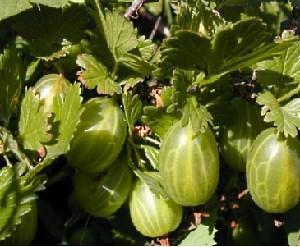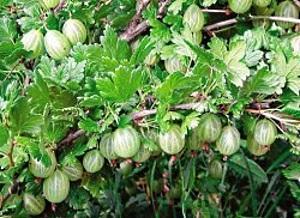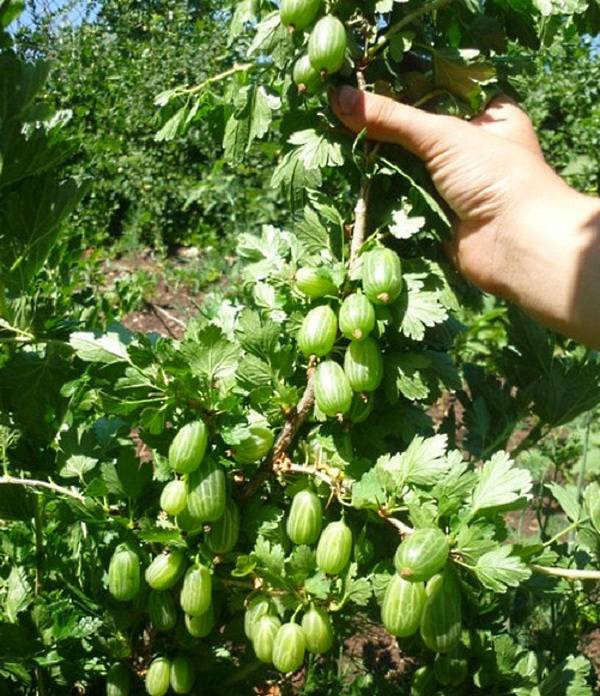Planting and caring for the Ural emerald gooseberry variety on a personal plot
 Nowadays, gooseberries can often be found in many gardeners' gardeners. Moreover varieties
very attractive both in the shape of the bushes and in the size of the fruits themselves.
Nowadays, gooseberries can often be found in many gardeners' gardeners. Moreover varieties
very attractive both in the shape of the bushes and in the size of the fruits themselves.
Such an ardent interest in gooseberries is explained by the content of vitamin C in it, which is twice as much as in lemon. Admiring large berries, there is a desire to plant such a miracle in your garden.
To choose from the entire offered assortment of gooseberry seedlings are varieties resistant to diseases, cold climates and high-yielding potential. One of these is the Ural Emerald, a dessert gooseberry variety.
Details about the gooseberry Ural emerald

Description of the gooseberry variety Ural emerald:
- features of the bushes - medium-sized, with a dense crown of branches, slightly spreading; young shoots are green in color, thick structure, covered along the entire length with medium-sized thorns, average thorniness;

- foliage - an uneven cover of small and large dark green leaves, which have a characteristic shiny appearance, wrinkled with sharp teeth;
- inflorescences - large dull pink, self-pollinating;
 fruits - large and medium-sized berries of an oval or round shape with thin seed walls, which have a green color; the taste of the fruit is sweet or sweet and sour; berries are used both for the preparation of juices and compotes, and preserves, jams and various medicinal infusions; are used both fresh and canned; frozen are used to quench thirst;
fruits - large and medium-sized berries of an oval or round shape with thin seed walls, which have a green color; the taste of the fruit is sweet or sweet and sour; berries are used both for the preparation of juices and compotes, and preserves, jams and various medicinal infusions; are used both fresh and canned; frozen are used to quench thirst;- yield indicator - from six kilograms of berries from one bush; fruits do not crumble, are easily removed from the branches;
- the degree of resistance to diseases - high resistance to powdery mildew, anthracnose, is not affected by butterflies, moths and pine sawflies;
- resistance to natural and climatic conditions - the variety is intended for cultivation in harsh Siberian conditions, winter-hardy.
The main advantages of the Ural Emerald gooseberry variety are high yield, cold tolerance, delicious large, beautiful aromatic sugar fruits of universal use.
The main disadvantages include the denseness of the bushes and the abundant thorniness.
Description of the gooseberry variety Ural emerald makes you want to acquire a decent plantation in order to collect excellent harvests, but the novice gardener should know that the indicator of the potential yield of the variety can be achieved only through proper planting of the shrub and caring for it.
Correct fit
 Since the Ural emerald gooseberry variety has a medium-spreading bush, several seedlings can be planted on a small garden plot at the same time, as shown in the photo, the emerging bushes from which will not interfere with each other, but, on the contrary, will improve the result of cross-pollination along with self-pollination, due to which it will be possible to achieve the highest yield of gooseberry.
Since the Ural emerald gooseberry variety has a medium-spreading bush, several seedlings can be planted on a small garden plot at the same time, as shown in the photo, the emerging bushes from which will not interfere with each other, but, on the contrary, will improve the result of cross-pollination along with self-pollination, due to which it will be possible to achieve the highest yield of gooseberry.
Ural emerald gooseberry loves sunlight, is unpretentious to temperature extremes, but very picky about soil fertility. It is well accepted in loamy loose areas.
In no case should you plant the Ural emerald gooseberry in lowland areas and on high-rise canopies.Lowlands are oversaturated with moisture, and hummocks are poor in moisture, and this variety prefers moderate moisture content in the soil.
This variety should be planted in the autumn; a good time for planting is between the end of September and the beginning of October. The most important point in this matter is to navigate according to weather forecasts and have time to plant gooseberries about three weeks before the first frost.
Planting gooseberries on time provides the seedlings with time to root. A properly planted gooseberry in the spring perfectly drives out young shoots and forms a strong fruitful bush.
 The spring period is more inclined not to planting, but to the reproduction of the Ural emerald. It is possible to plant gooseberries, having a uterine bush that has taken root, using the method of horizontal layers.
The spring period is more inclined not to planting, but to the reproduction of the Ural emerald. It is possible to plant gooseberries, having a uterine bush that has taken root, using the method of horizontal layers.
Rooted gooseberry layers for the spring-summer period are cut off from the mother bush in the fall and planted on areas of the garden favorable for their growth. During planting, be sure to add to the holes organic fertilizers.
Correct care
Since this variety is resistant to the main dangerous plant diseases, its care consists only in correct pruning, which is carried out in the fall, moderate watering, as well as weeding around the bush and periodic fertilization with organic and mineral nutrients.